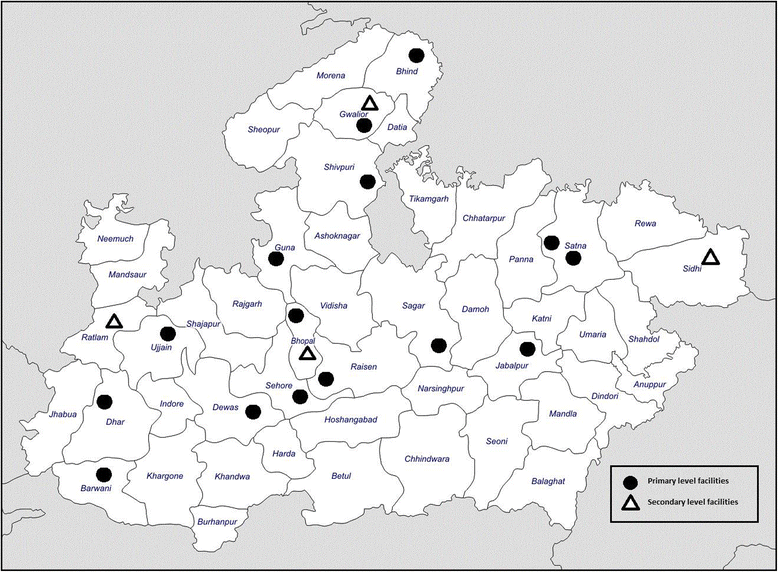An exploration of the socio-economic profile of women and costs of receiving abortion services at public health facilities of Madhya Pradesh, India
- PMID: 28320385
- PMCID: PMC5360007
- DOI: 10.1186/s12913-017-2159-6
An exploration of the socio-economic profile of women and costs of receiving abortion services at public health facilities of Madhya Pradesh, India
Abstract
Background: Maternal mortality, which primarily burdens developing countries, reflects the greatest health divide between rich and poor. This is especially pronounced for access to safe abortion services which alone avert 1 of every 10 maternal deaths in India. Primarily due to confidentiality concerns, poor women in India prefer private services which are often offered by untrained providers and may be expensive. In 2006 the state government of Madhya Pradesh (population 73 million) began a concerted effort to ensure access to safe abortion services at public health facilities to both rural and urban poor women. This study aims to understand the socio-economic profile of women seeking abortion services in public health facilities across this state and out of pocket cost accessing abortion services. In particular, we examine the level of access that poor women have to safe abortion services in Madhya Pradesh.
Methods: This study consisted of a cross-sectional client follow-up design. A total of 19 facilities were selected using two-stage random sampling and 1036 women presenting to chosen facilities with abortion and post-abortion complications were interviewed between May and December 2014. A structured data collection tool was developed. A composite wealth index computed using principal component analysis derived weights from consumer durables and asset holding and classified women into three categories, poor, moderate, and rich.
Results: Findings highlight that overall 57% of women who received abortion care at public health facilities were poor, followed by 21% moderate and 22% rich. More poor women sought care at primary level facilities (58%) than secondary level facilities and among women presenting for postabortion complications (67%) than induced abortion. Women reported spending no money to access abortion services as abortion services are free of cost at public facilities. However, poor women spend INR 64 (1 USD) while visiting primary level facilities and INR 256 (USD 4) while visiting urban hospitals, primarily for transportation and food.
Conclusions: Improved availability of safe abortion services at the primary level in Madhya Pradesh has helped meeting the need of safe abortion services among poor, which eventually will help reducing the maternal mortality and morbidity due to unsafe abortion.
Keywords: Cost of abortion; Economic profile of client; Evacuation technology; Public health facility; Safe abortion.
Figures
Similar articles
-
Availability and distribution of safe abortion services in rural areas: a facility assessment study in Madhya Pradesh, India.Glob Health Action. 2015 Mar 20;8:26346. doi: 10.3402/gha.v8.26346. eCollection 2015. Glob Health Action. 2015. PMID: 25797220 Free PMC article.
-
Abortion service provision in South Asia: A comparative study of four countries.Contraception. 2020 Sep;102(3):210-219. doi: 10.1016/j.contraception.2020.05.015. Epub 2020 May 29. Contraception. 2020. PMID: 32479764
-
Out of pocket expenditure to deliver at public health facilities in India: a cross sectional analysis.Reprod Health. 2016 Aug 24;13(1):99. doi: 10.1186/s12978-016-0221-1. Reprod Health. 2016. PMID: 27557904 Free PMC article.
-
The untold story: how the health care systems in developing countries contribute to maternal mortality.Int J Health Serv. 1992;22(3):513-28. doi: 10.2190/91YH-A52T-AFBB-1LEA. Int J Health Serv. 1992. PMID: 1644513 Review.
-
Towards comprehensive early abortion service delivery in high income countries: insights for improving universal access to abortion in Australia.BMC Health Serv Res. 2016 Oct 22;16(1):612. doi: 10.1186/s12913-016-1846-z. BMC Health Serv Res. 2016. PMID: 27770797 Free PMC article. Review.
Cited by
-
The microeconomics of abortion: A scoping review and analysis of the economic consequences for abortion care-seekers.PLoS One. 2021 Jun 9;16(6):e0252005. doi: 10.1371/journal.pone.0252005. eCollection 2021. PLoS One. 2021. PMID: 34106927 Free PMC article.
-
Socioeconomic inequalities in adverse pregnancy outcomes in India: 2004-2019.PLOS Glob Public Health. 2024 Sep 18;4(9):e0003701. doi: 10.1371/journal.pgph.0003701. eCollection 2024. PLOS Glob Public Health. 2024. PMID: 39292712 Free PMC article.
-
Association between Maternal Dietary Diversity and Low Birth Weight in Central India: A Case-Control Study.J Nutr Metab. 2021 May 30;2021:6667608. doi: 10.1155/2021/6667608. eCollection 2021. J Nutr Metab. 2021. PMID: 34194827 Free PMC article.
References
-
- Central Statistical Organization . Millennium Development Goals, India Country Report. New Delhi: Ministry of Statistics and Programme Implementation, Government of India; 2011.
-
- Registrar General of India . Maternal Mortality in India: 1997–2003. New Delhi: Registrar General of India; 2006.
-
- WHO . Trends in maternal mortality: 1990 to 2013. Estimates by WHO, UNICEF, UNFPA, The World Bank and the United Nations Population Division. Geneva: World Health Organization; 2014.
MeSH terms
LinkOut - more resources
Full Text Sources
Other Literature Sources
Medical


